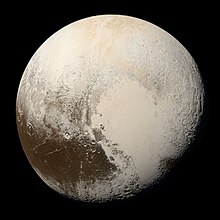Wikijunior:Solar System/Pluto
Pluto is a dwarf planet that was discovered by the astronomer Clyde W. Tombaugh in Arizona on February 18, 1930.[1]

How big is Pluto?
editPluto's mass is about 12,500,000,000,000,000,000,000 kilograms.[2] While this may seem large, it's only about 1/500th of the Earth's mass. Pluto is between 2200 and 2400 kilometers across.[3] Its surface area is about 17,950,000 square kilometers (or 1/30th of the Earth's).[4] Its volume is 7,150,000,000 km3 (or 1/150th of the Earth's).[5]
| The Solar System |
|
Introduction |
What is its surface like?
editPluto's surface is covered with ice.[6] It is very cold, at about -230 °C.[7] Pluto also has a very thin atmosphere which freezes when Pluto moves far away from the Sun.[8]
The image above on the right shows Pluto's color.
What are Pluto's moons like?
editPluto has three known moons. The largest is called Charon. Charon is about half as wide as Pluto. Because Pluto and Charon are so close in size, they are sometimes called a "double planet".[9] Charon's surface is covered in water ice.[10] Two other moons were discovered in 2005. They have been named Nix and Hydra.[11]
How long is a day on Pluto?
editOne day on Pluto is about 6.487 Earth days long. Like Uranus, Pluto also spins on its side.[12]
How long is a year on Pluto?
editOne year on Pluto would be about 90,613 days or 248 years on Earth![13]
What is it made of?
editScientists believe Pluto is made mostly of rock and ice,[14] but they will not be sure until more research is done. The discovery of Charon helped scientists estimate the density of Pluto. The information collected told them what Pluto was and was not made out of. If Pluto were made out of heavy solids, it would have a very high density. If it were made of gases, it would have a low density. Pluto is somewhere in between, so it is probably made of rock and ice.
How much would Pluto's gravity pull on me?
editIf you were on Pluto, gravity would be only 0.06 times as strong as it is on Earth. [15] This means you could do really high jumps—even more than people could on the Moon!
Who is Pluto named after?
editPluto was named after the Roman god of the underworld. In Roman mythology, he kidnapped Proserpina (Persephone) so he could marry her. This made her mother, Ceres, the goddess of agriculture, very sad, causing winter. To end winter, Jupiter, the king of the gods and her brother, decreed that Proserpina could return to the surface as long as she hadn't eaten any food of the Underworld. However, she had eaten six pomegranate seeds, so Jupiter decided she had to spend six months in the underworld each year. This is the Roman myth of winter. When she goes to the Underworld, everything stops growing. When she comes back, her mother is happy again, and life returns.[16]
In Roman mythology, Charon took dead souls across the river Acheron to the land of the dead.[17]
Is Pluto a planet?
editPluto has been officially classified as a dwarf planet, which is different from a regular planet. One reason is its small size - although it is the tenth largest known object that revolves around the sun, it is smaller than many moons, including Earth's moon. Scientists used to think that Pluto was a lot larger than it actually is,[18] and it was thought of as the ninth planet for many years.
Another key reason is that Pluto is part of a large group of objects called the Kuiper Belt, which all revolve around the Sun in the area beyond Neptune. In January 2005 another object "Eris" was discovered in the Kuiper Belt. Eris is larger than Pluto. Scientists think there are even more Pluto-sized objects in this part of the solar system, as well as millions of smaller objects. Because of this, the International Astronomical Union (IAU) defined the term 'planet' for the first time. Under the definition, both Eris and Pluto (along with Ceres, Haumea and Makemake) are dwarf planets.
In spite of this, some people continue to hold on to the idea that Pluto is a regular planet because of tradition. Also, some textbooks and references are not up to date, and still list Pluto as the ninth planet.
References
edit- ↑ http://nssdc.gsfc.nasa.gov/planetary/factsheet/plutofact.html
- ↑ Snow, Theodore P. (1996) "The Outer Planets." In The Dynamic Universe: An Introduction to Astronomy. pp. 285. West Publishing Company. ISBN 0-314-64212-9; http://nssdc.gsfc.nasa.gov/planetary/factsheet/plutofact.html
- ↑ Spinrad, Hyron. 2004 "Pluto." World Book Online Reference Center. 2004. World Book, Inc. http://www.worldbookonline.com/wb/Article?id=ar435500; http://www.nasa.gov/worldbook/pluto_worldbook.html; Snow, Theodore P. (1996) "The Outer Planets." In The Dynamic Universe: An Introduction to Astronomy. pp. 285. West Publishing Company. ISBN 0-314-64212-9; http://amazing-space.stsci.edu/resources/fastfacts/pluto.php.p=Astronomy+basics@,eds,astronomy-basics.php&a=,eds
- ↑ http://nssdc.gsfc.nasa.gov/planetary/factsheet/plutofact.html
- ↑ http://nssdc.gsfc.nasa.gov/planetary/factsheet/plutofact.html
- ↑ Snow, Theodore P. (1996) "The Outer Planets." In The Dynamic Universe: An Introduction to Astronomy. pp. 287. West Publishing Company. ISBN 0-314-64212-9; http://www.nasa.gov/worldbook/pluto_worldbook.html
- ↑ http://nssdc.gsfc.nasa.gov/planetary/factsheet/plutofact.html; Snow, Theodore P. (1996) "The Outer Planets." In The Dynamic Universe: An Introduction to Astronomy. pp. 285. West Publishing Company. ISBN 0-314-64212-9; http://www.nasa.gov/worldbook/pluto_worldbook.html
- ↑ Snow, Theodore P. (1996) "The Outer Planets." In The Dynamic Universe: An Introduction to Astronomy. pp. 287. West Publishing Company. ISBN 0-314-64212-9; http://nssdc.gsfc.nasa.gov/planetary/factsheet/plutofact.html
- ↑ http://solarsystem.nasa.gov/planets/profile.cfm?Object=Plu_Charon
- ↑ http://seds.lpl.arizona.edu/nineplanets/nineplanets/pluto.html
- ↑ http://www.space.com/scienceastronomy/060621_nix_hydra.html
- ↑ http://nssdc.gsfc.nasa.gov/planetary/factsheet/plutofact.html; http://www.nineplanets.org/pluto.html
- ↑ http://solarsystem.nasa.gov/planets/profile.cfm?Object=Pluto&Display=Overview
- ↑ http://seds.lpl.arizona.edu/nineplanets/nineplanets/pluto.html
- ↑ Snow, Theodore P. (1996) "The Outer Planets." In The Dynamic Universe: An Introduction to Astronomy. pp. 285. West Publishing Company. ISBN 0-314-64212-9; http://nssdc.gsfc.nasa.gov/planetary/factsheet/plutofact.html
- ↑ http://www.windows.ucar.edu/tour/link=/mythology/persephone_seasons.html; http://www.pantheon.org/articles/p/persephone.html
- ↑ http://www.pantheon.org/articles/c/charon.html
- ↑ Sobel, Dava (2005) "The Planets." pp. 220. Harper Perennial Publishing Company. ISBN 1-84115-621-3
